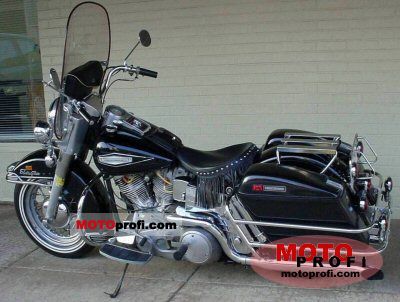



The third and final change given to the name of the basic FL model would occur in 1965, the final year of the "Panhead" engines. These last "Panheads" were the first "big-twin" Harley-Davidson engines to be equipped with electric starters, the Servi-Car having received electric start the year before. This innovation for Harley-Davidson was greeted with the new model name of Electra Glide.
In 1966, the "Panhead" gave way to the "Shovelhead," gaining a ten percent increase in power in the process.
A fork-mounted fairing became available on Electra Glides in 1969. This became unofficially known as the "batwing" fairing. Although the batwing fairing was an easily removable option on early Electra Glides, it was not removable on later machines, as the instruments were moved from the fuel tank into the fairing.
The FL frame was the basis for the 1971 FX Super Glide. The FX mated the FL frame with the forks of the XL Sportster, with buckhorn handlebars and a large fibreglass tailpiece completing the Super Glide specification.
The FL was given a front disc brake in 1972.The three speed plus reverse option was discontinued in 1977.
An 80 cubic inch (1.3 L) engine was made optional on the Electra Glide in 1978. However, the FL designation was not changed as a result. [12] By 1981, the 80 cubic inch (1.3 L) engine was the standard engine; the 74 cubic inch (1.2 L) engine being discontinued.
The low-compression FL engine was discontinued in 1979, as was the option for hand-shift/foot-clutch transmission controls.By : Wikipedia.com

No comments:
Post a Comment